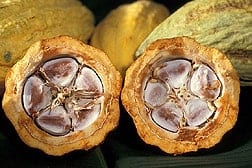U.S. Department of Agriculture (USDA) scientists have sequenced the frosty pod rot fungus genome. That advance could speed the development of cacao tree varieties that better withstand this costly blight.
The fungus that causes frosty pod rot disease, Moniliophthora roreri, occurs in most cacao-growing countries of Central and South America. Unchecked, the disease can destroy as much as 90 percent of the beans from which cocoa, cocoa butter, and ultimately chocolate are made.
Growers use an integrated approach to control frosty pod rot by planting cacao tree cultivars that tolerate the disease. However, the fungus has shown signs of changing tactics, a worrisome development for producers and consumers alike. During the past 15 years, losses to frosty pod rot have slowly increased for varieties once considered disease tolerant, notes Bryan Bailey, a plant pathologist with Agricultural Research Service‘s (ARS) Sustainable Perennial Crops Laboratory in Beltsville, Maryland.
Sequencing the fungus’s genome has enabled researchers to observe its biotrophic (surviving on living tissue) and necrotrophic (surviving on dead tissue) phases, as well as learn how the pathogen survives in cacao plants considered tolerant to infection. For example, one theory suggests the fungus is changing genetically enabling a rapid shift from a biotrophic to necrotrophic state.
The research team’s investigations included genetic sleuthing tracing the fungus to the upper Magdalena Valley of Colombia.
That discovery—reported in the August 2015 issue of Frontiers in Microbiology—has identified a location where researchers can search for cacao trees that are disease tolerant or resistant. Plant breeders could then transfer those newly identified genes into currently grown cultivars, notes Bailey.
ARS is USDA’s principal intramural scientific research agency.
Read more about this research in the July 2016 issue of AgResearch.
If our reporting has informed or inspired you, please consider making a donation. Every contribution, no matter the size, empowers us to continue delivering accurate, engaging, and trustworthy science and medical news. Independent journalism requires time, effort, and resources—your support ensures we can keep uncovering the stories that matter most to you.
Join us in making knowledge accessible and impactful. Thank you for standing with us!

